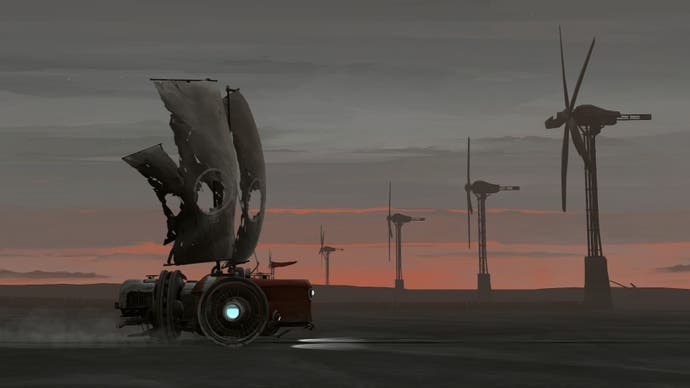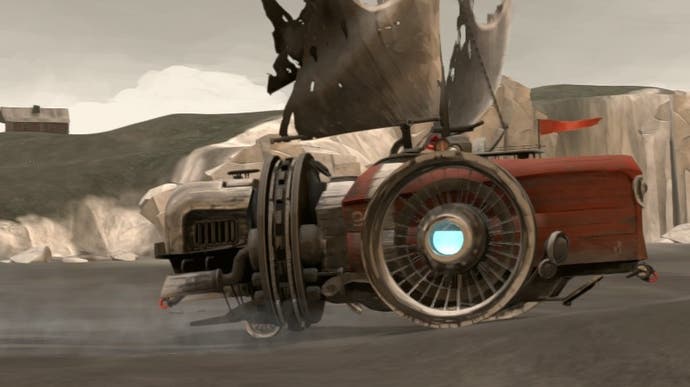FAR: Lone Sails review - outsailing the apocalypse
Tilting at windmills.
A sublime little side-scroller in the PlayDead tradition of child protagonists and looming industrial backdrops, FAR: Lone Sails is about going somewhere while staying put. It is the story of a girl, her features swallowed by a comically over-sized coat and hat, who embarks on a journey across a dried-up, abandoned continent after the loss of a loved one. The girl, however, does not do the journeying herself. She lives inside and operates a beautiful two-wheeled landship, its wooden frame peeling away when you board to reveal a dollhouse universe of cylinders and dials, swaying lanterns and pipes joined up by fat red buttons.
The landship is an immediate delight to interact with, from the way its engine backfires apoplectically to the sails that sprout like bullet-holed rabbit ears from its hull, allowing you to save precious fuel when the wind is at your back. It's also something of a pain in the arse, and all the more endearing for it. The vessel's tank only has enough fuel for a moment or so of forward movement, obliging frequent trips to the stern to load another crate into the incinerator, and you'll need to vent steam regularly to stop things bursting or catching fire. Fuel itself is more abundant than you might guess from the post-apocalytic premise (I suspect the game drops it ahead of you, depending on your performance) but it's important to be efficient, timing each top-up just right so that you eke the most from your supply while never squandering momentum by letting the engine fall quiet. You learn to save time by hopping across the roof of the rope elevator at the ship's waist, and to leave a crate on the incinerator platform, ready to go in an emergency.
Another game might have lost itself in all this bustling about, in the gradual optimisation of a space that is at once a loyal companion, a mobile home and a gorgeous analog toy, its fittings and surfaces directed outward at the player. But for every moment spent fussing over the vehicle, there's a moment in Lone Sails when you're free or forced by some external obstacle to look away, and to appreciate the contrast your rumbling haven forms with the world you're moving through. Huge oil tankers lean monstrously over dessicated seabeds. Wrecked factories reach their chimneys through sickly yellow light. Red banners flicker in the hearts of snowy railway yards.
The game's landscapes channel the same theme of colossal machine death as Big Robot's The Signal from Tölva - at one point you'll crash your landship through the belly of a beached submarine, like a worm tunnelling through a corpse - but there are notes of optimism. One sequence sees you sailing against a rose-coloured horizon as windmills sail on-screen from the right, a celebration of eco-power tempered by the reminder of a certain infamous scene in Don Quixote. As you absorb these vistas, you realise how beautifully they are synchronised to, drawn along by the game's score, with tracks building slowly through layers of instrumentation as your rightward movement exposes fresh wonders. FAR: Lone Sails can be crudely summarised as a "puzzle-platformer", but it often feels more like a music game, the player's task being not to beat the terrain but to keep the soundtrack in motion. The landship is a needle running along the groove of a record that spans valleys, mountains, deserts and oceans, the plunging of day into night and the gradual erasure of constellations by the sunrise.

As to what precisely has befallen the setting of Lone Sails - this is, as you may expect, hinted at in the background art but never spelled out. At intervals you're required to disembark and meddle with some enormous contraption - a radio tower, a motorised bridge, a smelting plant - digging into the backstory a little as you power up generators and haul counterweights to unlock the way forward, sometimes using the landship itself as a tool. One of the game's moments of real ecstasy comes when you realise what exactly you are inside, and the rhythms of ship management you've picked up assume a grander form. As an exploration of civilisation's collapse, Lone Sails lacks the complexity or powerful irresolution of the Playdead platformers it resembles, but that's not a criticism in itself. This is more of a fairy tale than a cautionary one: the only thing you really need know about the society implied by these ruins is that it rose and it fell and there is still hope.
Integral to the last part is that the game has the confidence not to give every prop an explicit function: some things, it suggests, are simply valuable in themselves. Besides crates of fuel, there are objects you might pick up and take with you because they feel like they should belong to someone: a working radio, a potted flower, a model galleon, an old book. You can decorate the vessel with them, hanging them up alongside your supplies to stop them tumbling out the rear hatch. The child also has a bedroom at the top of the landship, crayon doodles traversing the woodwork over a lamplit bed. It's a chamber that exists not for the player's benefit but to assert that she has a life beyond her role in the game - that she is not, in the end, just a cog in the machine.



